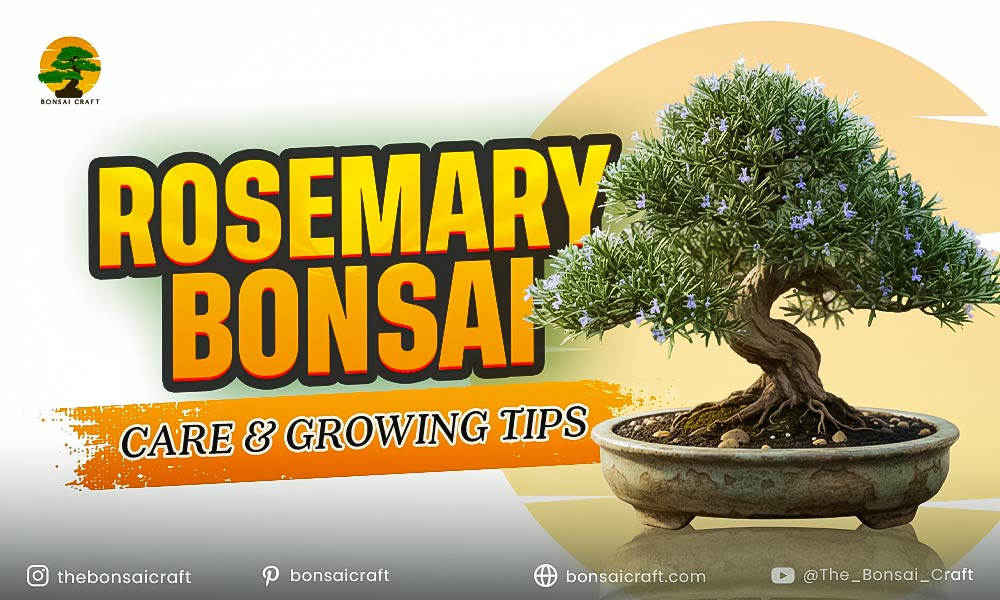
Growing a rosemary bonsai is both an art and a rewarding gardening experience. This aromatic herb, traditionally used in Mediterranean cuisine, transforms beautifully into a bonsai rosemary tree when cultivated with care. With its fragrant leaves, resilience, and evergreen nature, it’s an excellent choice for bonsai enthusiasts who want a plant that combines beauty, utility, and symbolism.
This guide covers everything you need to know about rosemary bonsai care, from styling and pruning to watering, indoor growing, and training methods. Whether you’re a beginner learning how to bonsai rosemary or an experienced gardener exploring advanced rosemary bonsai styles, this article provides expert tips rooted in hands-on experience.
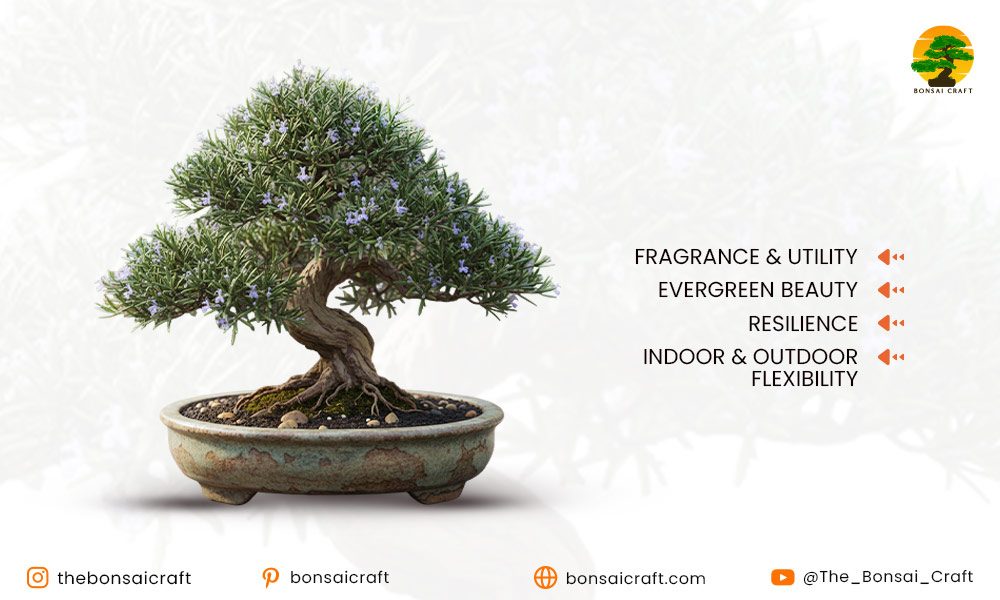
Why Choose a Rosemary Bonsai?
A rosemary bonsai plant offers several benefits beyond aesthetics:
- Fragrance & Utility – Fresh rosemary can be harvested for cooking and herbal teas.
- Evergreen Beauty – Its needle-like leaves and woody stems provide year-round appeal.
- Resilience – Rosemary adapts well to pruning, shaping, and different bonsai styles.
- Indoor & Outdoor Flexibility – With proper care, rosemary bonsai indoors or outdoors.
Additionally, rosemary symbolizes remembrance and loyalty, making it a meaningful bonsai choice.
How to Start a Rosemary Bonsai
You can choose from seedlings, nursery plants, and cuttings to grow a Rosemary bonsai. Of the three choices, cuttings are the most effective since they take root quickly and keep the offspring’s genetic features. Properly and strategically pruning the cutting as well as applying wire helps to achieve the right bonsai shape.
Methods to Begin:
- Cuttings (Best Method) – Remove semi-hardwood cuttings from a healthy Rosemary plant and use some rooting hormone, then place the cuttings in a well-draining rooting soil.
- Seeds – Slow and less predictable but possible for patient growers.
- Nursery Plants – Purchase a Rosemary shrub and sculpturally train the shrub into a bonsai rosemary tree.
Starting with cuttings ensures faster growth and more control over bonsai styling.
Best Soil for Rosemary Bonsai
Rosemary thrives in well-draining soil. A gritty, sandy mix is best, preventing root rot.
- Recommended mix: 40% akadama, 30% pumice, 30% lava rock or coarse sand.
- Avoid heavy soils that hold water.
- pH should be slightly alkaline to neutral (6.5–7.5).
How to Grow a Rosemary Bonsai Indoors
A rosemary bonsai indoors needs strong sunlight, proper air circulation, and minimal watering. Place it in a south-facing window or under grow lights, and ensure the soil is well-drained to prevent root rot.
Key Indoor Growing Tips:
- Light – Minimum 6–8 hours of direct sunlight or grow lights.
- Airflow – Keep near an open window or use a small fan.
- Temperature – Prefers 60–75°F (15–24°C). Avoid cold drafts.
- Humidity – Moderate humidity helps, but avoid excessive misting which can cause fungal issues.
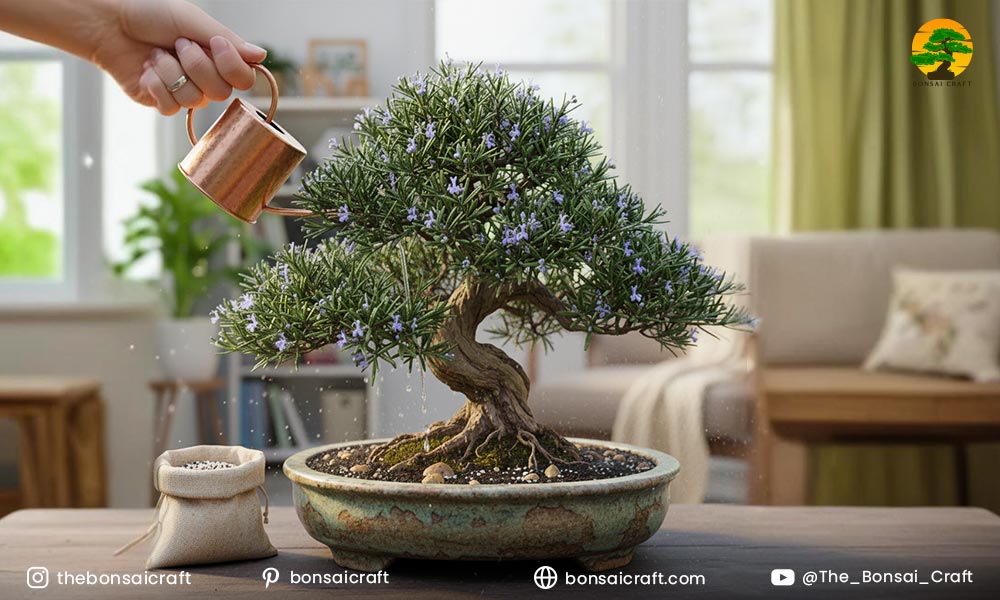
Watering & Fertilizing Rosemary Bonsai
Rosemary hates overwatering.
- Watering Rule: Only water when the top inch of soil feels dry.
- Drainage: Ensure pots have drainage holes.
- Fertilizer: Apply a balanced, diluted liquid fertilizer once every 4 weeks during growing season (spring–fall). Reduce feeding in winter.
Rosemary Bonsai Pruning & Styling
Rosemary bonsai pruning should be done regularly to maintain shape, encourage branching, and prevent woodiness. Trim soft new growth often, but avoid cutting into old, woody stems, as they rarely resprout.
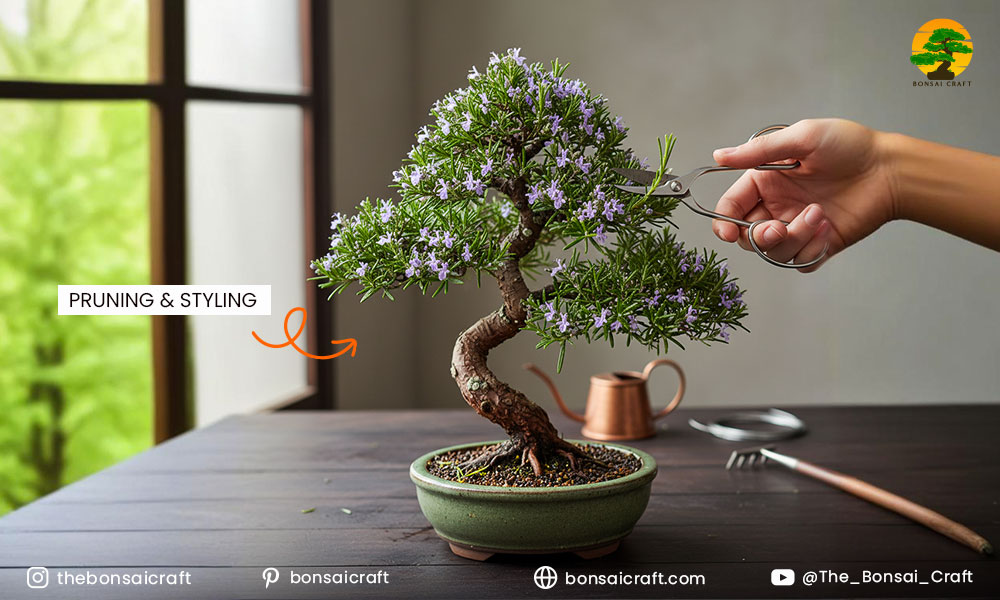
Styling Options:
Popular rosemary bonsai styles include:
- Informal Upright (Moyogi) – Natural and easy for beginners.
- Cascade (Kengai) – Dramatic but requires wiring and patience.
- Broom Style (Hokidachi) – A rounded crown with balanced branching.
- Slanting (Shakan) – Resembles a windswept tree.
Wiring: Use aluminum wire on young, flexible stems. Avoid over-bending older woody branches.
Pruning Tips:
- Pinch back new shoots regularly.
- Avoid heavy pruning in winter.
- Shape gradually to reduce stress.
How to Repot a Rosemary Bonsai
Repot every 2–3 years in early spring.
- Remove 20–30% of the root mass.
- Use fresh, well-draining soil.
- Trim thick roots but keep fine feeder roots intact.
- Place in a shallow bonsai pot with good drainage.
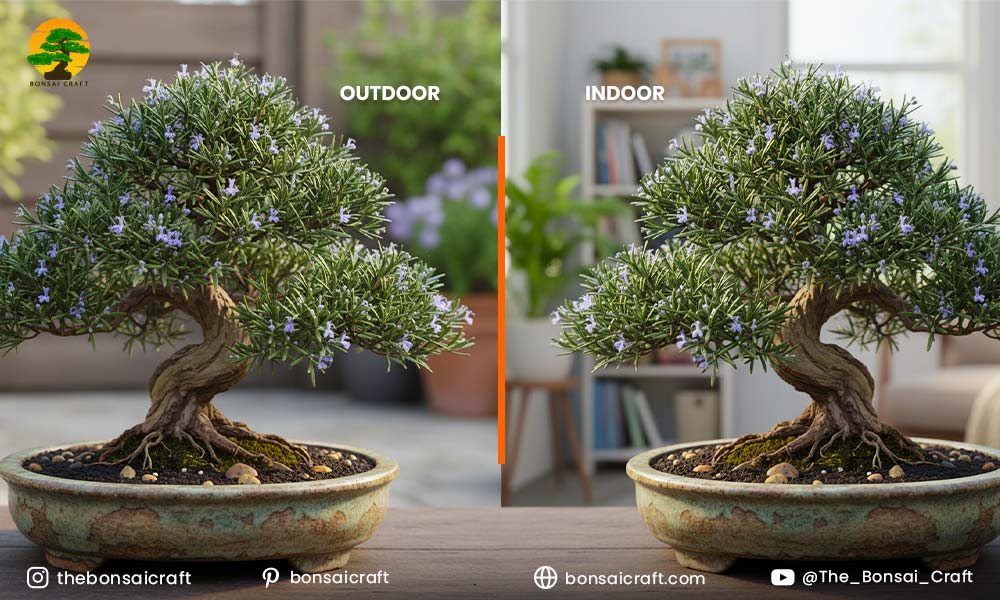
Rosemary Bonsai Indoor vs Outdoor Growing
Indoors:
- Works well in colder climates with grow lights.
- Requires strict watering control.
- More prone to pests like spider mites indoors.
Outdoors:
- Ideal in Mediterranean or temperate climates.
- Needs full sun and free airflow.
- Can tolerate drought once established.
If you live in a cold region, overwinter indoors and keep outdoors in warm months.
How to Make a Rosemary Bonsai (Step-by-Step)
To make a rosemary bonsai, start with a small rosemary shrub, prune it into shape, wire branches for styling, and plant it in a shallow bonsai pot. Over time, consistent pruning and care will transform it into a miniature tree.
Step Guide:
- Select a young rosemary plant.
- Prune unwanted branches to define trunk line.
- Wire main branches to establish style.
- Repot into a shallow bonsai container.
- Maintain shape with regular pruning and watering.
Common Problems in Rosemary Bonsai Care
- Root Rot – From poor drainage or overwatering.
- Powdery Mildew – Caused by high humidity and poor airflow.
- Spider Mites/Aphids – Common in rosemary bonsai indoors.
- Leggy Growth – From lack of pruning or insufficient light.
Conclusion
A rosemary bonsai tree combines the charm of bonsai art with the practicality of a fragrant herb. By mastering rosemary bonsai care—from proper watering and soil choice to pruning and styling—you can grow a miniature tree that is both beautiful and useful.
As an expert tip: Always prioritize airflow and drainage, since rosemary thrives in drier conditions compared to most bonsai species. With patience and consistent care, your bonsai rosemary plant can live for many years, rewarding you with its fragrance and timeless elegance.
FAQs About Rosemary Bonsai
How to bonsai a rosemary plant?
You can bonsai a rosemary plant by pruning it, wiring the branches, and shallow planting it into a bonsai pot. If you maintain consistent care and pruning, it will become a mini tree.
Can rosemary bonsai grow indoors?
Yes, rosemary bonsai indoors is possible with strong sunlight, proper airflow, and careful watering. Without adequate light, rosemary will become weak and leggy.
How often should I water a rosemary bonsai?
Only water whenever the soil feels dry. Do not set a fixed schedule. Make sure to remove excess water after watering the bonsai as over watering to the roots can cause root rot.
What are the best rosemary bonsai styles?
Some styles include the informal upright, slanting, cascade, and broom styles. These styles work well with rosemary’s evergreen leaves and natural branching.
How long does a rosemary bonsai live?
A rosemary bonsai with proper maintenance can live over 20 years. This includes regular pruning, repotting, and continuous disease management.
